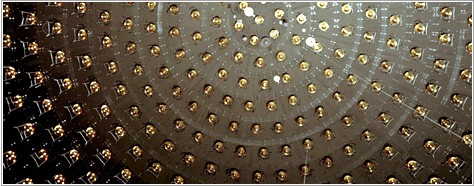
The inside of the MiniBooNE tank (Courtesy: Fermilab Visual Media Services)
By James Dacey
Last week, I reported a result to emerge from the MINOS experiment at Fermilab, which – if confirmed – will add a fascinating new dimension to our understanding of neutrinos. The researchers were looking at a feature known as neutrino oscillation, whereby these elusive particles mysteriously switch identity between the three different flavours of neutrino.
According to all conventional models, the extent to which this process occurs should be the same for neutrinos as it is for antineutrinos. But to their great surprise, the MINOS team discovered that this is not the case. They found that the energy over which this process occurs in muon neutrinos and muon antineutrinos (converting into tau neutrinos and tau antineutrinos, respectively) is different by around 40%.
A MINOS spokesperson, Jenny Thomas of University College London, told me that the audience was “very surprised” by the result when it was presented last week at the Neutrino 2010 conference in Athens, Greece. But the 2 sigma confidence level seems to have restricted the results to causing a minor ripple, not a soaring wave, in the particle-physics community.
Crashing in behind this MINOS announcement, however, is a new result at a fellow Fermilab experiment that will surely add momentum to their findings. Researchers at the MiniBooNe experiment say that they have seen a similar discrepancy but with muon neutrinos – at a lower energy – oscillating into electron neutrinos (and the related process for muon antineutrinos). What’s more, their results are presented to a confidence of 3 sigma.
David Wark, a neutrino physicist at Imperial College, London, says that if either MINOS or MiniBooNE are correct, “it would not be a surprise but an overwhelming shock”. He points out, however, that the experiments take measurements of different oscillations and don’t directly support each other. “In both cases, we need to see more data,” he says.
Fortunately for Wark (or unfortunately, depending on how big that shock is), MINOS and MiniBooNe are both continuing to take data for at least the next couple of years. It will be interesting to see what happens next.



